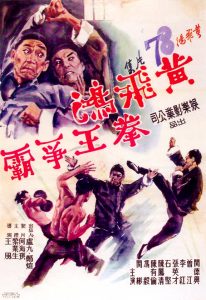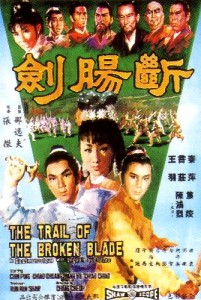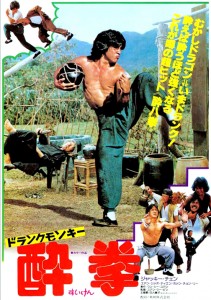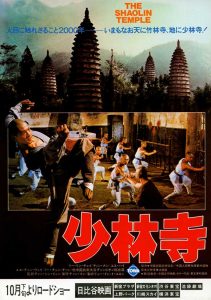List-making is an interesting but challenging exercise in distillation, especially when you’re whittling down the history of an entire genre to just a handful of movies. Obviously, the following is not a comprehensive “best of” list: it overlooks many directors and performers who have made significant contributions to the Chinese martial arts film. But each of these movies represents a milestone in the development of a genre which continues to evolve and still commands an enormous audience.
These are the trendsetters, the shapers of an art form… the films which are the essence of their type.
1. The Story of Wong Fei-hung, Part 1 (1949)
For all intents and purposes, this is where the genre begins. Playing the role of real-life hung gar instructor/acupuncturist/Cantonese folk hero Wong Fei-hung (1847-1924) in a series of films which lasted until the early 1970s, Kwan Tak-hing became a star. In contrast to the wholesale slaughter which has become a hallmark of martial arts movies, the Wong Fei-hung series emphasized forbearance. In the Chinese fighting arts, wu de, or the martial code of conduct, is of vital importance: the character wu literally means “stop fighting”. It is this point that Kwan Tak-hing wished to convey to his audience. This movie’s subtitle, Whip Extinguishes the Candles, is a reference to Wong’s demonstration of his skill with the chain whip (one of kung fu’s “soft” weapons) in the final scene.
2. Trail of the Broken Blade (1967)
In 1967, the conventions of the Chinese martial arts film were still being established. Its most popular subgenre was the heroic swordplay film, well exemplified by Trail of the Broken Blade.
Critics don’t think very highly of this movie (almost unanimously they prefer The One-Armed Swordsman, made a few months later by the same director and star), but it was the prototype for nearly every subsequent Chang Cheh film… and for just about everything else, since Chang was so widely imitated.
All the elements of his formula are here: a stern, chivalrous hero who faces seemingly impossible odds; a supervillain who resides at the center of an impregnable fortress, and whose henchmen wield an array of exotic weapons; and, of course, messy stomach wounds. This film was a groundbreaker, genre history be damned.

3. The Chinese Boxer (1970)
Having exhausted the potential of heroic swordplay, Wang Yu (now a matinee idol of the first order) parted company with Chang Cheh and set about making his own movies. The Chinese Boxer (aka Hammer of God) was the first “basher”, as the hand-to-hand fighting films of the early 1970s are now commonly called, and from here on out the swordplay film declined in popularity.
In terms of plot, the bashers were fundamentally the same as the sword-fighting movies, but had a much more overtly macho vibe: in The Chinese Boxer there’s no trace of the stylized delicacy which had characterized the swordplay subgenre.
The action looks pretty raw by today’s standards, but it’s bloody and there’s a lot of it. As the ruthless, chestnut-haired karateka with whom Wang squares off in the film’s climax, Lo Lieh began his long reign as the archvillain of Chinese martial arts movies.
4. Enter the Dragon (1973)
Wang Yu was a superstar in Asia, but Bruce Lee became a worldwide sensation. This, his fourth and final film, made the biggest splash internationally.
Lee himself choreographed the fight scenes, which were designed to showcase his speed and accuracy, and chose Shih Kien – a veteran of the Wong Fei-hung films – to portray the villain. Angela Mao, the greatest female kung fu movie star, has a small but very memorable role as the sister of Lee’s character. (John Saxon and Jim Kelly, Lee’s American co-stars, received prominent billing but were just along for the ride.)
Enter the Dragon is marred only by Lee’s distressingly gaunt appearance; just thirty-two years old, he died before the film was released. Even now, rumors abound that his death was the result of foul play.
5. The 36th Chamber of Shaolin (1978)
Originally an action choreographer for Chang Cheh, Liu Chia-liang began directing his own films in 1975. This is his masterpiece, and the progenitor of an international Shaolin craze.
Gordon Liu plays San Te, a real-life Buddhist monk who takes methodical revenge on the Manchurian general (Lo Lieh) who murdered his parents. Following his showdown with the general, San Te trains a new generation of revolutionaries at Shaolin Temple.
Upon its release in the United States, the movie was luridly retitled The Master Killer: ironic, since most of its 115-minute running time is devoted to authentic martial arts training scenes. Nearly all of the fights take place in the film’s final half-hour, showcasing a mixture of hand-to-hand combat and clashes between weapons like the three sectional staff and the double broadswords.
6. Drunken Master (1978)
Directed by Yuen Woo-ping, this is Jackie Chan’s second (and best) comedy kung fu adventure, and the one that spawned 1978’s other martial arts movie fad. (A few of the drunken boxing films, like Snake in the Monkey’s Shadow, are pretty good despite being knockoffs.)
Simon Yuen, father of the director and another alumnus of the Wong Fei-hung films, portrays Chan’s elderly, wine-quaffing instructor; Korean kicking maestro Hwang Jang-lee plays the bad guy.
This is worlds removed from the Jackie Chan with whom American audiences got acquainted in the 1990s, and his brand of slapstick comedy can grate on the nerves if you’re not in the mood for it, but Drunken Master allows you to see a superstar in the making. After this film, Chan could—and did—write his own ticket, assuming full creative control as had Wang Yu earlier in the decade.
7. Shaolin Temple (1982)
The first kung fu film to be shot in mainland China and Jet Li’s cinematic debut, Shaolin Temple is essentially an alternate version of The 36th Chamber of Shaolin (but set in an earlier historical period). It had the distinction of renewing China’s interest in its own martial heritage after years of cultural repression under Mao Tse-tung, and the fast, vigorous choreography reflects the popularity of sport wushu on the mainland during the early 1980s.
Liu Chia-liang supervised the shooting of a few scenes in Hong Kong, but Chang Hsin-yen’s Shaolin Temple represented the emergence of a new style which resembled the Hong Kong films only superficially. It gave birth to a sequel, Kids from Shaolin, as well as vastly inferior imitations like The Shaolin Brothers.
The history of Chinese martial arts movies didn’t come to a screeching halt in 1982, of course. Their development continued at a steady pace, from Jackie Chan films like Project A (1983) and Police Story (1985) through Crouching Tiger, Hidden Dragon (2000), director Ang Lee’s revival of the heroic swordplay film. Critical recognition of the genre as a legitimate art form was belated, but today critics and mass audiences alike understand what we kung fu movie fanatics have known all along: that these films represent one of the greatest achievements in world cinema.










Well written article…takes me back to Kung Fu Theater! Great research!
Great article, and nice to see ‘The Trail of the Broken Blade’ getting some recognition! This has always been my favorite collaboration between Jimmy Wang Yu and Chang Cheh, so even though I watched it 35 years after it came out, it was still easy to see the impact it would have had.
Awesome list.
To me, at least one more Bruce Lee film should be added – either The Big Boss (when this opened, everyone in HK was talking about it and Bruce’s waves shook the Shaw Bros. studio, and automatically put every major HK star at 2nd best); or maybe Fists of Fury, which practically sealed the deal as far as Bruce Lee creating a paradigm shift on how rage, revenge and cinematic prowess. All of the sudden, Shaw Brothers had a rock solid competitor, because of this one man.
Good article, I’ve seen three of the films listed so I still have some watching to do. In the future when such lists are presented it would be nice to have viewing options listed (Amazon, Netflix etc)
In the past, we’ve tried to keep streaming lists updated, but it just becomes a lost cause to keep current since Netflix/Amazon have titles that are always leaving, etc. The best thing to do, at least for Amazon Prime, is to a search like this (basically it’s a search using the key words: martial arts, movies, amazon video)